 W
WThe Ain al-Kheil Mosque, also known as the al-Azhar Mosque, is a historic mosque in Fes el-Bali, the old medina of Fes, Morocco.
 W
WThe Alcázar Genil is a Muslim-era palace in the city of Granada, Spain. It was originally called al-Qasr al-Sayyid and is located beside the River Genil outside the Alhambra's walls. Today, only a pavilion of the palace is preserved.
 W
WBab Agnaou is one of the best-known gates of Marrakesh, Morocco. Its construction is attributed to the Almohad caliph Abu Yusuf Ya'qub al-Mansur and was completed around 1188 or 1190.
 W
WBab er Robb is a southern city gate in the historic medina of Marrakech, Morocco.
 W
WBab er-Rouah is a monumental gate in the Almohad-era ramparts of Rabat, Morocco.
 W
WBab Ftouh is the main southeastern gate of Fes el-Bali, the old walled city of Fes, Morocco.
 W
WBab Guissa or Bab Gisa is the main northwestern gate of Fes el Bali, the old walled city of Fes, Morocco.
 W
WBab Mahrouk, also spelled Bab Mahruq, is historically the main western city gate of Fes el Bali, the old walled city of Fes, Morocco. The gate dates from 1204 and is located on the northwestern corner of Place Bou Jeloud, near the edge of Kasbah an-Nouar. It was historically the approximate starting point of the old city's main street, Tala'a Kebira.
 W
WBab Oudaya, also known as Bab Lakbir or Bab al-Kabir, is the monumental gate of the Kasbah of the Udayas in Rabat, Morocco. The gate, built in the late 12th century, is located at the northwest corner of the Kasbah, uphill from the medina of Rabat. It is often cited as one of most beautiful gates of Almohad and Moroccan architecture.
 W
WThe Bou Jeloud Mosque is a historic Almohad-era mosque in the former Kasbah of Bou Jeloud, located near Bab Bou Jeloud, in Fes, Morocco.
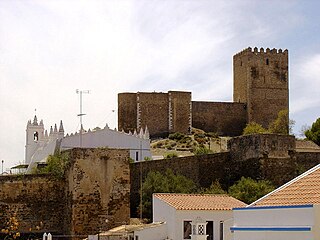 W
WThe Castle of Mértola is a well-preserved medieval castle located in the civil parish and municipality of Mértola, in the Portuguese district of Beja.
 W
WThe Castle of San Jorge was a medieval fortress built on the west bank of the Guadalquivir river in the Spanish city of Seville (Spain). It was also used as headquarters and prison for the Spanish Inquisition. It was demolished in the 19th century and made into a food market. A museum in the underground ruins focuses on the history of the castle, the Spanish Inquisition and of religious repression. Next to the food market in the Barrio de Triana, the Alley of the Inquisition, which was part of the fortifications, now connects Castilla Street with the Nuestra Señora de la O Walk.
 W
WThe Moorish Castle is the name given to a medieval fortification in Gibraltar comprising various buildings, gates, and fortified walls, with the dominant features being the Tower of Homage and the Gate House. Part of the castle itself also housed the prison of Gibraltar until it was relocated in 2010. The Tower of Homage is clearly visible to all visitors to Gibraltar; not only because of its striking construction, but also because of its dominant and strategic position. Although sometimes compared to the nearby alcazars in Spain, the Moorish Castle in Gibraltar was constructed by the Marinid dynasty, making it unique in the Iberian Peninsula.
 W
WThe Chellah or Shalla, is a medieval fortified Muslim necropolis located in the metro area of Rabat, Morocco, on the south (left) side of the Bou Regreg estuary. The Phoenicians established a trading emporium at the site. This was later the site of an ancient Roman colony in the province of Mauretania Tingitana.
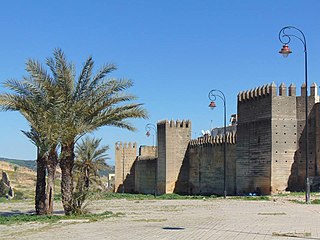 W
WThe Fortifications of Fez comprise a complex circuit of ramparts and gates surrounding Fes el-Bali and Fes el-Jdid, two urban agglomerations that compose the old "medina" of Fes, Morocco. They also include a number of kasbahs (citadels) and forts which were built both to protect and to control the city. These fortifications have been built up over many centuries and the extensive remnants today date from many different periods.
 W
WThe Giralda is the bell tower of Seville Cathedral in Seville, Spain. It was built as the minaret for the Great Mosque of Seville in al-Andalus, Moorish Spain, during the reign of the Almohad dynasty, with a Renaissance-style belfry added by the Catholics after the expulsion of the Muslims from the area. The Giralda was registered in 1987 as a World Heritage Site by UNESCO, along with the Alcázar and the General Archive of the Indies. The tower is 104.1 m (342 ft) in height and remains one of the most important symbols of the city, as it has been since the Middle Ages.
 W
WThe Great Mosque of Taza is the most important religious building in the historic medina of Taza, Morocco. Founded in the 12th century, it is the oldest surviving example of Almohad architecture, although it was expanded by the Marinids in the late 13th century.
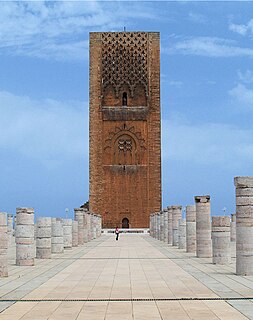 W
WHassan Tower or Tour Hassan is the minaret of an incomplete mosque in Rabat, Morocco. It was commissioned by Abu Yusuf Yaqub al-Mansur, the third Caliph of the Almohad Caliphate, near the end of the 12th century. The tower was intended to be the largest minaret in the world, and the mosque, if completed, would have been the largest in the western Muslim world. When al-Mansur died in 1199, construction on the mosque stopped. The minaret was left standing at a height of 44 meters. The rest of the mosque was also left incomplete, with only the beginnings of several walls and 348 columns being constructed. The tower, along with the remains of the mosque and the modern Mausoleum of Mohammed V, forms an important historical and tourist complex in Rabat.
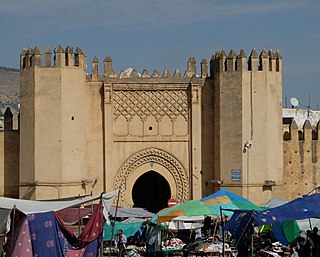 W
WThe Kasbah An-Nouar or Kasbah Filali is a walled district and former military enclosure in the old medina of Fez, Morocco. Its name means "citadel of the flowers", but it is sometimes also referred to as Kasbah Filala and Kasbah Chorfa. It is one of several fortified military enclosures or kasbahs that were built around the old city of Fez across different periods.
 W
WKasbah Mahdiyya is a kasbah located near the city of Kenitra, Morocco. It is situated at the downstream of Sebou River in the vicinity of the Atlas Mountains, 12km from the city of Kneitra. The kasbah was built during the era of the Berber Almohad sultan Abd al-Mu'min, and restored during the Alaouite period in the 17th century.
 W
WThe Kasbah Mosque is a historic mosque in Marrakesh, Morocco. It was originally built by the Almohad caliph Yaqub al-Mansour in 1185-1190 CE. It is located in the Kasbah district, the city's former citadel, near the site of its historic royal palaces. Along with the Kutubiyya Mosque, it is one of the most important historic mosques in Marrakesh.
 W
WThe Kasbah of Marrakesh is a large walled district in the southern part of the medina of Marrakesh, Morocco, which historically served as the citadel (kasbah) and royal palace complex of the city. A large part of the district is still occupied by the official royal palace, the Dar al-Makhzen, which serves as the residence of the King of Morocco when he visits the city. The rest of the district consists of various neighbourhoods and monuments. It was founded by the Almohads in the late 12th century, with most of the construction carried out by Caliph Ya'qub al-Mansur. Two of its most important surviving structures today, the Kasbah Mosque and the main gate of Bab Agnaou, date from al-Mansur's reign.
 W
WThe Kasbah of the Udayas, also spelled Kasbah of the Oudaias or of the Oudayas, is a kasbah (citadel) in Rabat, Morocco. It is located at the mouth of the Bou Regreg river, opposite Salé, and adjacent to the old medina of Rabat. It is listed, along with other sites in Rabat, as a UNESCO World Heritage Site.
 W
WThe Kutubiyya Mosque or Koutoubia Mosque is the largest mosque in Marrakesh, Morocco. The mosque's name is also variably rendered as Jami' al-Kutubiyah, Kutubiya Mosque, Kutubiyyin Mosque, and Mosque of the Booksellers. It is located in the southwest medina quarter of Marrakesh, near the famous public place of Jemaa el-Fna, and is flanked by large gardens.
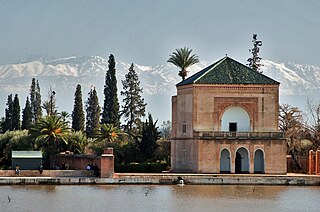 W
WThe Menara Gardens are a historic public garden and orchard in Marrakech, Morocco. They were established in the 12th century by the Almohad Caliphate ruler Abd al-Mu'min. Along with the Agdal Gardens and the historic walled city of Marrakesh, the gardens have been listed as UNESCO World Heritage Site since 1985. The gardens are laid out around a central water basin and reservoir, next to which is a pleasure pavilion dating in its current form from the 19th century. The reservoir and its pavilion, often framed in pictures against the background of the High Atlas Mountains to the south, are considered one of the iconic views and symbols of Marrakesh.
 W
WThe Mosque of the Andalusians or Al-Andalusiyyin Mosque, sometimes also called the Andalusian Mosque, is a major historic mosque in Fes el Bali, the old medina quarter of Fez, Morocco. The mosque was founded in 859-860, making it one of the oldest mosques in Morocco. It is located at the heart of a district which was historically associated with Andalusi immigrants, from which it takes its name. It has been renovated and expanded several times since then. Today, it is one of the relatively few remaining Idrisid-era establishments and one of the main landmarks of the city.
 W
WThe Oued Tensift Bridge is a historic bridge over the Tensift River located just north of Marrakesh in Morocco. It was originally built during the Almohad period in the 12th century.
 W
WThe Castle of Paderne is an ancient fortification located in the civil parish of Paderne, municipality of Albufeira, in the Portuguese Algarve. It was constructed in the later 12th century by Berbers, in an area around 7.5 kilometres (4.7 mi) inland. The edifice is located just 8.2 kilometres (5.1 mi) from the resort town of Albufeira, along a bend in the Quarteira River. It is believed to be one of the original castles that occupy the shield of the Portuguese national flag.
 W
WThe Synagogue of Santa María la Blanca is a museum and former synagogue in Toledo, Spain. Erected in 1180, according to an inscription on a beam, it is disputably considered the oldest synagogue building in Europe still standing. It is now owned and preserved by the Catholic Church.
 W
WThe Tinmal Mosque or Great Mosque of Tinmal is a 12th-century mosque located in the village of Tinmel in the High Atlas Mountains of Morocco. Although no longer operating as a mosque today, its remains are preserved as a historic site. It was built at the site where Ibn Tumart, the founder of the Almohad movement, was buried and it is considered an important example of Almohad architecture.
 W
WThe Torre de la Plata is an octagonal military tower in Andalusia, located in present-day Seville, southern Spain. It was constructed by the Almohad Caliphate.
 W
WThe Torre del Oro is a dodecagonal military watchtower in Seville, southern Spain. It was erected by the Almohad Caliphate in order to control access to Seville via the Guadalquivir river.
 W
WThe Walls of Marrakesh are a set of defensive ramparts which enclose the historic medina districts of Marrakesh, Morocco. They were first laid out in the early 12th century by the Almoravid dynasty which founded the city in 1070 CE as their new capital. The walls have since been expanded several times by the addition of the Kasbah to the south at the end of the 12th century and by the later extension of the walls to encompass the neighbourhood around the Zawiya of Sidi Bel Abbes.